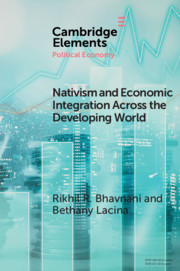Element contents
Nativism and Economic Integration across the Developing World
Published online by Cambridge University Press: 16 August 2018
Summary
Keywords
Information
- Type
- Element
- Information
- Series: Elements in Political EconomyOnline ISBN: 9781108678063Publisher: Cambridge University PressPrint publication: 21 February 2019
References
Accessibility standard: Unknown
Why this information is here
This section outlines the accessibility features of this content - including support for screen readers, full keyboard navigation and high-contrast display options. This may not be relevant for you.Accessibility Information
- 21
- Cited by
